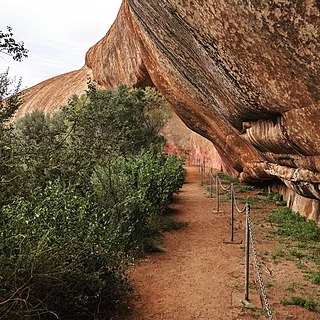
Batavia ( ) was a ship of the Dutch East India Company (VOC). She was built in Amsterdam in 1628 as the flagship of one of the three annual fleets of company ships and sailed that year on her maiden voyage for Batavia, capital of the Dutch East Indies. On 4 June 1629, Batavia was wrecked on the Houtman Abrolhos, a chain of small islands off the western coast of Australia.

Willem Hesselsz de Vlamingh was a Dutch sea captain who explored the central west coast of New Holland (Australia) in the late 17th century, where he landed in what is now Perth on the Swan River. The mission proved fruitless, but he charted parts of the continent's western coast.
Ridderschap van Holland was a large retourschip, the largest class of merchantmen built by the Dutch East India Company to trade with the East Indies. In 1694 the ship sailed for Batavia on her fifth voyage, but was never heard from again. She is now thought to have been shipwrecked off the west coast of Australia.
The Western Australian Museum is a statutory authority within the Culture and the Arts Portfolio, established under the Museum Act 1969.

A castaway is a person who is cast adrift or ashore. While the situation usually happens after a shipwreck, some people voluntarily stay behind on a desert island, either to evade captors or the world in general. A person may also be left ashore as punishment (marooned).
The Vergulde Draeck, also spelled Vergulde Draak and Vergulde Draek, was a 41.8-metre (137 ft), 260-tonne (290-ton) ship constructed in 1653 by the Dutch East India Company.

The Zeewijk was an 18th-century East Indiaman of the Dutch East India Company that was shipwrecked at the Houtman Abrolhos, off the coast of Western Australia, on 9 June 1727. The survivors built a second ship, the Sloepie, enabling 82 out of the initial crew of 208 to reach their initial destination of Batavia on 30 April 1728. Since the 19th century many objects were found near the wreck site, which are now in the Western Australian Museum. The shipwreck itself was found in 1968 by divers.
Over 1400 ships have been wrecked on the coast of Western Australia. This relatively large number of shipwrecks is due to a number of factors, including:
Tryall was a British East India Company-owned East Indiaman launched in 1621. She was under the command of John Brooke when she was wrecked on the Tryal Rocks off the north-west coast of Western Australia in 1622. Her crew were the first Englishmen to sight or land on Australia. The wreck is Australia's oldest known shipwreck.

The Zuytdorp Cliffs extend for about 150 km (93 mi) along a rugged, spectacular and little visited segment of the Western Australian Indian Ocean coast. The cliffs extend from just south of the mouth of the Murchison River at Kalbarri, to Pepper Point south of Steep Point. The cliffs are situated in both the Gascoyne and Mid West regions of the state.

Walga Rock, also known as Walgahna Rock and Walganna Rock, is a granite monolith situated about 48 kilometres (30 mi) west of Cue, Western Australia, within the Austin Downs pastoral lease. It is one of the largest granite monoliths in Australia.

Wiebbe Hayes was a Dutch soldier known for his leading role in the suppression of Jeronimus Cornelisz's massacre of shipwreck survivors in 1629, after the merchant ship Batavia was wrecked in the Houtman Abrolhos, a chain of coral islands off the west coast of Australia.
SS Xantho was a steam ship used in the colony of Western Australia as a pearling transport and mothership, as a tramp steamer, carrying passengers, including Aboriginal convicts and trade goods before she sank at Port Gregory, Western Australia in 1872. She was powered by a horizontal trunk engine.

Rupert Gerritsen was an Australian historian and a noted authority on Indigenous Australian prehistory. Coupled with his work on early Australian cartography, he played an influential part in re-charting Australian history prior to its settlement by the British in 1788, and noted evidence of agriculture and settlements on the continent before the arrival of settlers.
The Australian Netherlands Committee on Old Dutch Shipwrecks (ANCODS) is an organization tasked with maintaining and allocating artefacts from 17th and 18th century Dutch shipwrecks off the coast of Western Australia. It was founded in 1972 by the Agreement between Australia and the Netherlands Concerning Old Dutch Shipwrecks.

Max Cramer OAM was an Australian scuba diver who became famous as the co-discoverer of the wreck of the Batavia on 4 June 1963. He was involved in a number of maritime archaeology projects pertaining to historic shipwrecks in Western Australia.

The Wiebbe Hayes Stone Fort on West Wallabi Island is the oldest surviving European building in Australia and was built in 1629 by survivors of the Batavia shipwreck and massacre. West Wallabi Island is 63 km (39 mi) from the coast of Western Australia.
Phillip Elliott Playford was an Australian geologist who made important contributions to sedimentary geology, oil exploration in Western Australia, maritime history, and made contributions to the recording of Aboriginal art and culture from the north of Western Australia.
The Malgana, also known as the Malkana, are an Aboriginal Australian people of Western Australia.

Graeme Henderson is an Australian maritime historian and maritime archaeologist. Since the early 1970s he played a leading role in developing maritime archaeology and maritime museums in Australia, having assisted in, or led the investigation of wrecks in the Fremantle area as well as on the Western Australian coast, on islands offshore and in the Eastern States. Henderson was the first Director of the new Western Australian Maritime Museum on Victoria Quay from 1992 to 2005.












